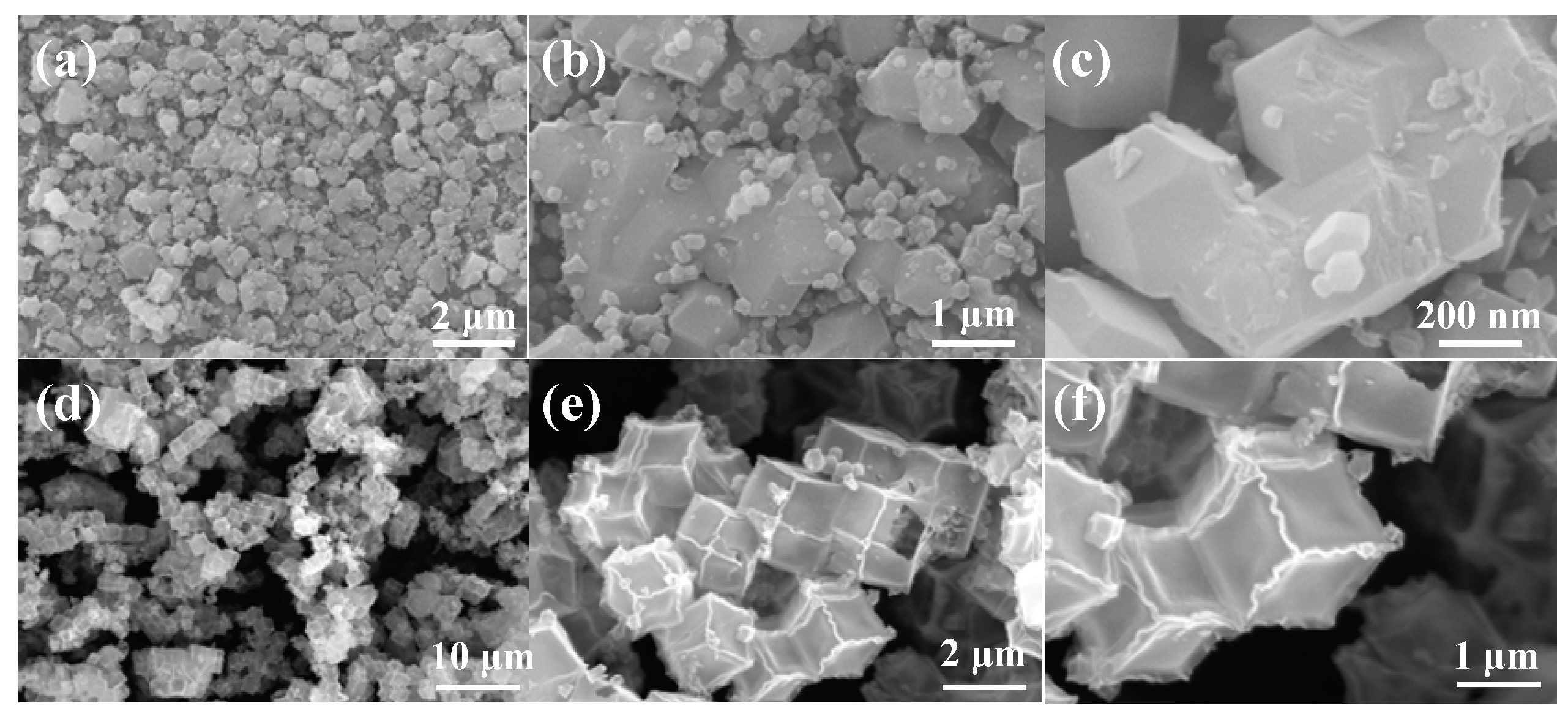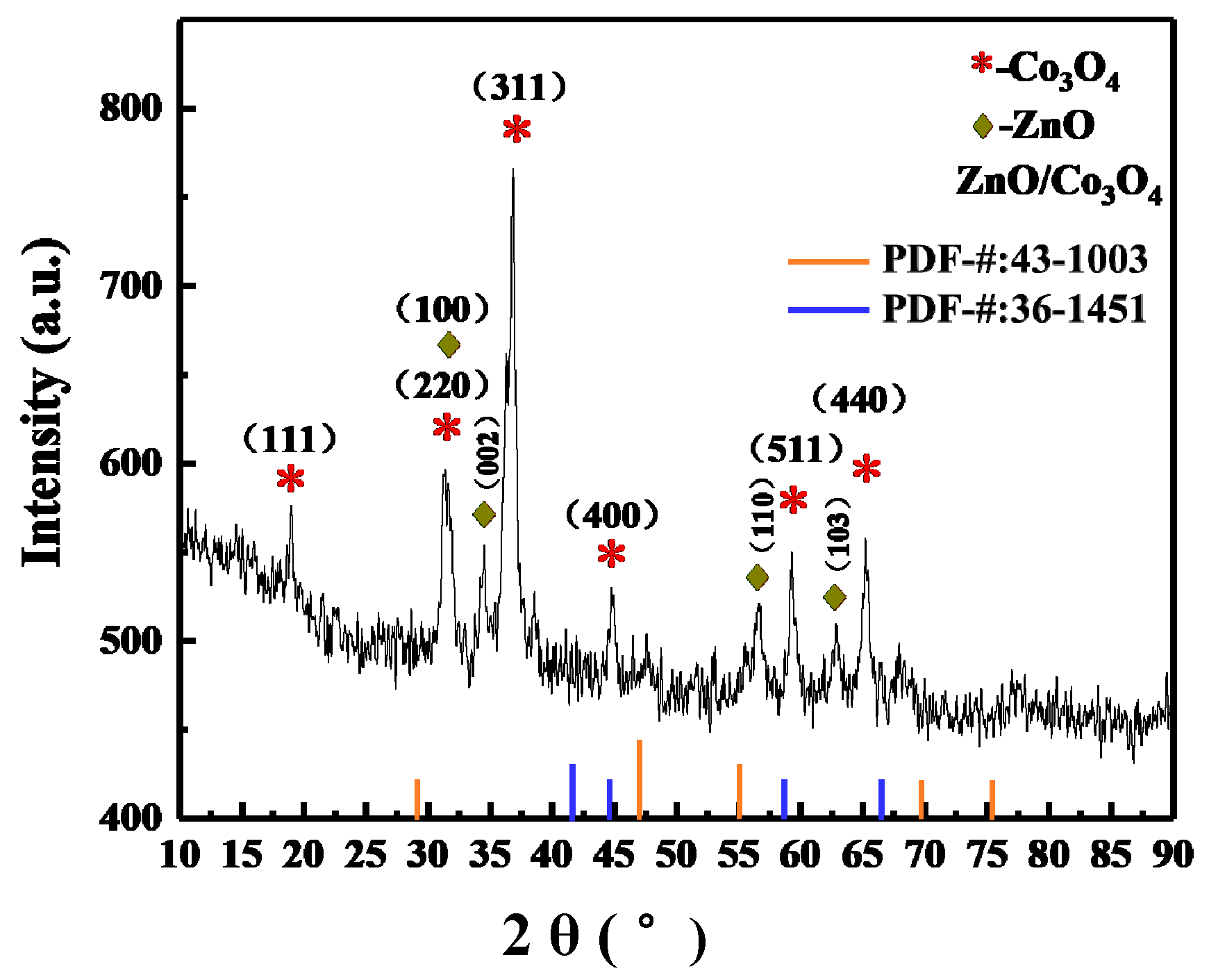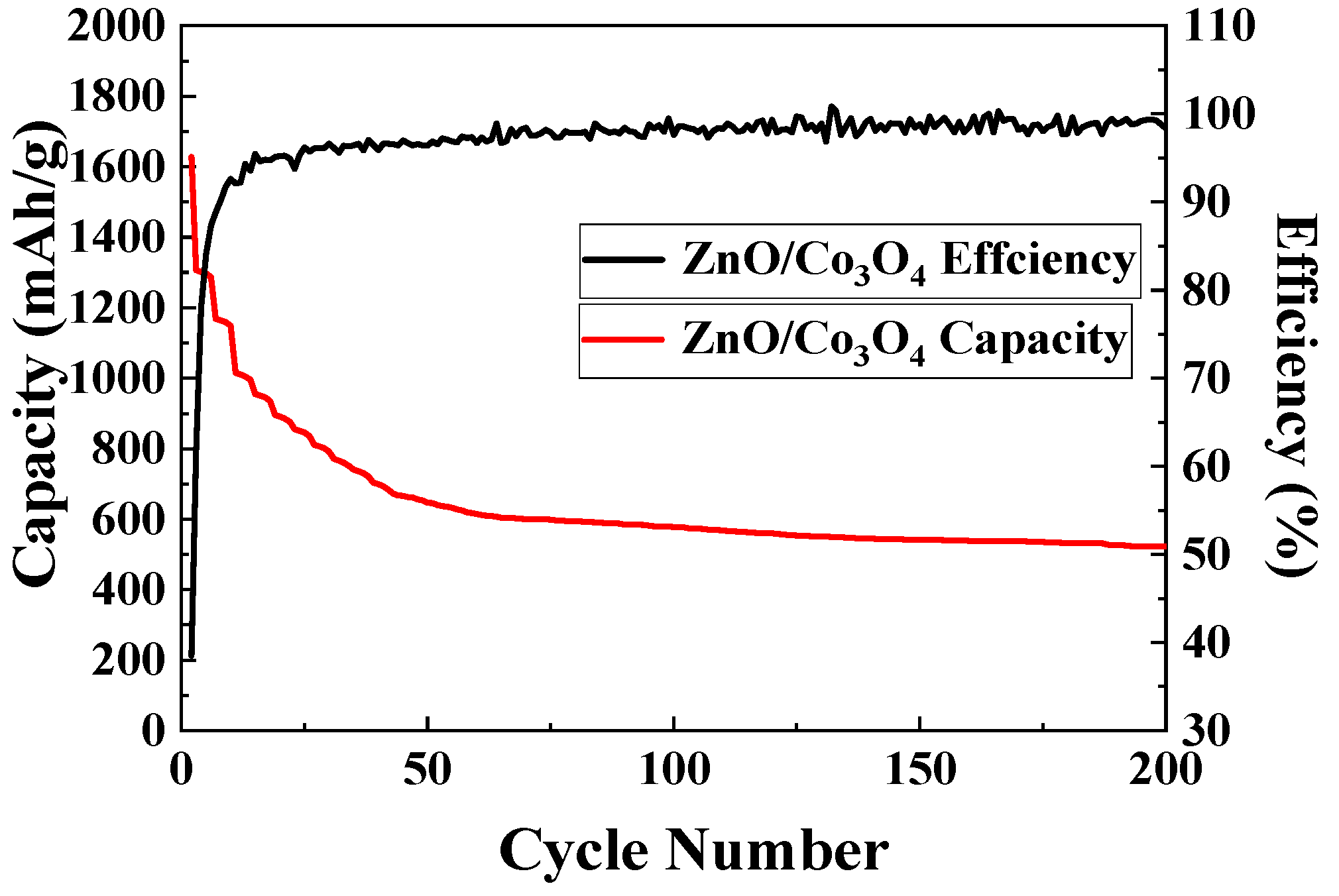MOF-Derived Hetero-Zn/Co Hollow Core-Shell TMOs as Anode for Lithium-Ion Batteries
Abstract
:1. Introduction
2. Experimental
2.1. Preparation of Zn-Co-MOF
2.2. Preparation of ZnO/Co3O4
2.3. Material Characterization Test
2.4. Electrochemical Test
3. Results and Discussion
3.1. Analysis and Characterization
3.2. Electrochemical Performance
4. Conclusions
Author Contributions
Funding
Institutional Review Board Statement
Informed Consent Statement
Data Availability Statement
Conflicts of Interest
References
- Wang, L.; Zhang, G.; Liu, Q.; Duan, H. Recent progress in Zn-based anodes for advanced lithium ion batteries. Mater. Chem. Front. 2018, 2, 1414–1435. [Google Scholar] [CrossRef]
- Deng, J.; Li, M.; Wang, Y. Biomass-derived carbon: Synthesis and applications in energy storage and conversion. Green Chem. 2016, 18, 4824–4854. [Google Scholar] [CrossRef]
- Goodenough, J.B.; Kim, Y. Challenges for Rechargeable Li Batteries. Chem. Mater. 2010, 22, 587–603. [Google Scholar] [CrossRef]
- Tan, Y.; Yang, C.; Qian, W.; Sui, X.; Teng, C.; Li, Q.; Lu, Z. Carbon coated porous Co3O4 polyhedrons as anode materials for highly reversible lithium-ion storage. J. Alloy. Compd. 2021, 855, 157387. [Google Scholar] [CrossRef]
- Sengottaiyan, S.; Shiva, G.; Ammar, H.; Fadl, A.; Zakaria, M.; Anjanapura, V. Investigation into the effects of SiO2/TiO2 nanolayer on the thermal performance of solar box type cooker. Energy Sources A Recovery Util. Environ. Eff. 2021, 43, 2724–2737. [Google Scholar]
- Jonnalagadda, M.; Prasad, V.; Kakarla, R.; Venkata, R.; Anjanapura, V. Facile synthesis of Ni-doped ZnS-CdS composite and their magnetic and photoluminescence properties. J. Environ. Chem. Eng. 2021, 6, 106335. [Google Scholar]
- Wu, Y.; Meng, J.; Li, Q.; Niu, C.; Wang, X.; Yang, W.; Li, W.; Mai, L. Interface-modulated fabrication of hierarchical yolk-shell Co3O4/C dodecahedrons as stable anodes for lithium and sodium storage. Nano Res. 2017, 10, 2364–2376. [Google Scholar] [CrossRef]
- Shao, J.; Wan, Z.; Liu, H.; Zheng, H.; Gao, T.; Shen, M.; Qu, Q.; Zheng, H. Metal organic frameworks-derived Co3O4 hollow dodecahedrons with controllable interiors as outstanding anodes for Li storage. J. Mater. Chem. A 2014, 2, 12194–12200. [Google Scholar] [CrossRef]
- Li, J.; Yan, D.; Hou, S.; Lu, T.; Yao, Y.; Chua, D.; Pan, L. Metal-organic frameworks derived yolk-shell ZnO/NiO microspheres as high-performance anode materials for lithium-ion batteries. Chem. Eng. J. 2018, 335, 579–589. [Google Scholar] [CrossRef]
- Nam, K.C.; Seon, Y.H.; Bandyopadhyay, P.; Cho, J.S.; Jeong, S.M. Porous nanofibers comprising hollow Co3O4/Fe3O4 nanospheres and nitrogen-doped carbon derived by Fe@ZIF-67 as anode materials for lithium-ion batteries. Int. J. Energy Res. 2022, 46, 8934–8948. [Google Scholar] [CrossRef]
- Yang, W.; Li, X.; Li, Y.; Zhu, R.; Pang, H. Applications of Metal-Organic-Framework-Derived Carbon Materials. Adv. Mater. 2019, 31, 1804740. [Google Scholar] [CrossRef] [PubMed]
- Karthik, K.V.; Reddy, C.; Reddy, K.R.; Ravishankar, R.; Sanjeev, G.; Kulkarni, R.V.; Shetti, N.P.; Raghu, A.V. Barium titanate nanostructures for photocatalytic hydrogen generation and photodegradation of chemical pollutants. J. Mater. Sci. Mater. Electron. 2019, 30, 20646–20653. [Google Scholar] [CrossRef]
- Al, N.; Siddique, S.; Aisida, S.; Altowairqi, Y.; Fadhali, M.; Shariq, M.; Khan, M.; Qamar, M.; Shahid, T.; Shahzad, M.; et al. Structural, Magnetic, and Magnetothermal Properties of Co100−xNix Nanoparticles for Self-Controlled Hyperthermia. Coatings 2022, 12, 1272. [Google Scholar]
- Zhang, Y.; Li, Y.; Chen, J.; Zhao, P.; Li, D.; Mu, J.; Zhang, L. CoO/Co3O4/graphene nanocomposites as anode materials for lithium-ion batteries. J. Alloy. Compd. 2017, 699, 672–678. [Google Scholar] [CrossRef]
- Xiu, Z.L.; Alfaruqi, M.H.; Gim, J.; Song, J.; Kim, S.; Duong, P.T.; Baboo, J.P.; Mathew, V.; Kim, J. MOF-derived mesoporous anatase TiO2 as anode material for lithium-ion batteries with high rate capability and long cycle stability. J. Alloy. Compd. 2016, 674, 174–178. [Google Scholar] [CrossRef]
- Sun, D.; Tang, Y.; Ye, D.; Yan, J.; Zhou, H.; Wang, H. Tuning the Morphologies of MnO/C Hybrids by Space Constraint Assembly of Mn-MOFs for High Performance Li Ion Batteries. ACS Appl. Mater. Interfaces 2017, 9, 5254–5262. [Google Scholar] [CrossRef]
- Gallo, M.; Polverino, P.; Mougin, J.; Morel, B.; Pianese, C. Coupling electrochemical impedance spectroscopy and model-based aging estimation for solid oxide fuel cell stacks lifetime prediction. Appl. Energy 2020, 279, 115718. [Google Scholar] [CrossRef]
- Li, Y.; Li, Q.; Wang, H.; Huang, Y.; Zhang, X.; Wu, Q.; Gao, H.; Yang, J. Synthesis and electrochemical properties of nickel-manganese oxide on MWCNTs/CFP substrate as a supercapacitor electrode. Appl. Energy 2015, 153, 78–86. [Google Scholar] [CrossRef]
- Di Blasi, A.; Busaccaa, C.; Di Blasia, O.; Briguglioa, N.; Squadritoa, G.; Antonuccia, V. Synthesis of flexible electrodes based on electrospun carbon nanofibers with Mn3O4 nanoparticles for vanadium redox flow battery application. Appl. Energy 2017, 190, 165–171. [Google Scholar] [CrossRef]
- Xiong, D.; Li, X.; Shan, H.; Yan, B.; Li, D.; Langford, C.; Sun, X. Scalable synthesis of functionalized graphene as cathodes in Li-ion electrochemical energy storage devices. Appl. Energy 2016, 175, 512–521. [Google Scholar] [CrossRef]
- Kundu, S.; Sain, S.; Yoshio, M.; Kar, T.; Gunawardhana, N.; Pradhan, S.K. Structural interpretation of chemically synthesized ZnO nanorod and its application in lithium ion battery. Appl. Surf. Sci. 2015, 329, 206–211. [Google Scholar] [CrossRef]
- Li, Z.; Li, B.; Yin, L.; Qi, Y. Prussion Blue-Supported Annealing Chemical Reaction Route Synthesized Double-Shelled Fe2O3/Co3O4 Hollow Microcubes as Anode Materials for Lithium-Ion Battery. ACS Appl. Mater. Interfaces 2014, 6, 8098–8107. [Google Scholar] [CrossRef] [PubMed]








| Element | Value | Error | Error% |
|---|---|---|---|
| Rs | 3.615 | 0.11065 | 3.0609 |
| CPE1-T | 2.7689 × 10−5 | 2.195 × 10−6 | 7.9273 |
| CPE1-P | 0.6874 | 0.0072492 | 1.0546 |
| RCT | 157 | 8.5552 | 5.4492 |
| W1 | 56.36 | 25.91 | 45.972 |
| Samples | Morphology and Structure | Initial Specific Capacity | Cycle Performance | Rate Performance |
|---|---|---|---|---|
| Co3O4 | spherical | 1113 mAh g−1 | 150 mAh g−1 after 50 cycles | 162 mAh g−1 at 400 mA/g |
| ZnO | cylindrical shaped nanorods | 1226 mAh g−1 | 230 mAh g−1 after 100 cycles | 320 mAh g−1 at 300 mA/g |
| ZnO/Co3O4 | dodecahedral structure | 1250 mAh g−1 | 640 mAh g−1 after 100 cycles | 513 mAh g−1 at 400 mA/g |
Publisher’s Note: MDPI stays neutral with regard to jurisdictional claims in published maps and institutional affiliations. |
© 2022 by the authors. Licensee MDPI, Basel, Switzerland. This article is an open access article distributed under the terms and conditions of the Creative Commons Attribution (CC BY) license (https://creativecommons.org/licenses/by/4.0/).
Share and Cite
Pan, J.; Gong, M.; Cui, W.; Zheng, G.; Song, M. MOF-Derived Hetero-Zn/Co Hollow Core-Shell TMOs as Anode for Lithium-Ion Batteries. Coatings 2022, 12, 1487. https://doi.org/10.3390/coatings12101487
Pan J, Gong M, Cui W, Zheng G, Song M. MOF-Derived Hetero-Zn/Co Hollow Core-Shell TMOs as Anode for Lithium-Ion Batteries. Coatings. 2022; 12(10):1487. https://doi.org/10.3390/coatings12101487
Chicago/Turabian StylePan, Junfeng, Ming Gong, Wenhao Cui, Guoxu Zheng, and Mingxin Song. 2022. "MOF-Derived Hetero-Zn/Co Hollow Core-Shell TMOs as Anode for Lithium-Ion Batteries" Coatings 12, no. 10: 1487. https://doi.org/10.3390/coatings12101487
APA StylePan, J., Gong, M., Cui, W., Zheng, G., & Song, M. (2022). MOF-Derived Hetero-Zn/Co Hollow Core-Shell TMOs as Anode for Lithium-Ion Batteries. Coatings, 12(10), 1487. https://doi.org/10.3390/coatings12101487






